Shujun Wang
Think Before You Move: Latent Motion Reasoning for Text-to-Motion Generation
Dec 30, 2025Abstract:Current state-of-the-art paradigms predominantly treat Text-to-Motion (T2M) generation as a direct translation problem, mapping symbolic language directly to continuous poses. While effective for simple actions, this System 1 approach faces a fundamental theoretical bottleneck we identify as the Semantic-Kinematic Impedance Mismatch: the inherent difficulty of grounding semantically dense, discrete linguistic intent into kinematically dense, high-frequency motion data in a single shot. In this paper, we argue that the solution lies in an architectural shift towards Latent System 2 Reasoning. Drawing inspiration from Hierarchical Motor Control in cognitive science, we propose Latent Motion Reasoning (LMR) that reformulates generation as a two-stage Think-then-Act decision process. Central to LMR is a novel Dual-Granularity Tokenizer that disentangles motion into two distinct manifolds: a compressed, semantically rich Reasoning Latent for planning global topology, and a high-frequency Execution Latent for preserving physical fidelity. By forcing the model to autoregressively reason (plan the coarse trajectory) before it moves (instantiates the frames), we effectively bridge the ineffability gap between language and physics. We demonstrate LMR's versatility by implementing it for two representative baselines: T2M-GPT (discrete) and MotionStreamer (continuous). Extensive experiments show that LMR yields non-trivial improvements in both semantic alignment and physical plausibility, validating that the optimal substrate for motion planning is not natural language, but a learned, motion-aligned concept space. Codes and demos can be found in \hyperlink{https://chenhaoqcdyq.github.io/LMR/}{https://chenhaoqcdyq.github.io/LMR/}
An Anatomy of Vision-Language-Action Models: From Modules to Milestones and Challenges
Dec 19, 2025Abstract:Vision-Language-Action (VLA) models are driving a revolution in robotics, enabling machines to understand instructions and interact with the physical world. This field is exploding with new models and datasets, making it both exciting and challenging to keep pace with. This survey offers a clear and structured guide to the VLA landscape. We design it to follow the natural learning path of a researcher: we start with the basic Modules of any VLA model, trace the history through key Milestones, and then dive deep into the core Challenges that define recent research frontier. Our main contribution is a detailed breakdown of the five biggest challenges in: (1) Representation, (2) Execution, (3) Generalization, (4) Safety, and (5) Dataset and Evaluation. This structure mirrors the developmental roadmap of a generalist agent: establishing the fundamental perception-action loop, scaling capabilities across diverse embodiments and environments, and finally ensuring trustworthy deployment-all supported by the essential data infrastructure. For each of them, we review existing approaches and highlight future opportunities. We position this paper as both a foundational guide for newcomers and a strategic roadmap for experienced researchers, with the dual aim of accelerating learning and inspiring new ideas in embodied intelligence. A live version of this survey, with continuous updates, is maintained on our \href{https://suyuz1.github.io/VLA-Survey-Anatomy/}{project page}.
Ada-FCN: Adaptive Frequency-Coupled Network for fMRI-Based Brain Disorder Classification
Nov 16, 2025Abstract:Resting-state fMRI has become a valuable tool for classifying brain disorders and constructing brain functional connectivity networks by tracking BOLD signals across brain regions. However, existing mod els largely neglect the multi-frequency nature of neuronal oscillations, treating BOLD signals as monolithic time series. This overlooks the cru cial fact that neurological disorders often manifest as disruptions within specific frequency bands, limiting diagnostic sensitivity and specificity. While some methods have attempted to incorporate frequency informa tion, they often rely on predefined frequency bands, which may not be optimal for capturing individual variability or disease-specific alterations. To address this, we propose a novel framework featuring Adaptive Cas cade Decomposition to learn task-relevant frequency sub-bands for each brain region and Frequency-Coupled Connectivity Learning to capture both intra- and nuanced cross-band interactions in a unified functional network. This unified network informs a novel message-passing mecha nism within our Unified-GCN, generating refined node representations for diagnostic prediction. Experimental results on the ADNI and ABIDE datasets demonstrate superior performance over existing methods. The code is available at https://github.com/XXYY20221234/Ada-FCN.
* MICCAI2025
Medical Knowledge Intervention Prompt Tuning for Medical Image Classification
Nov 16, 2025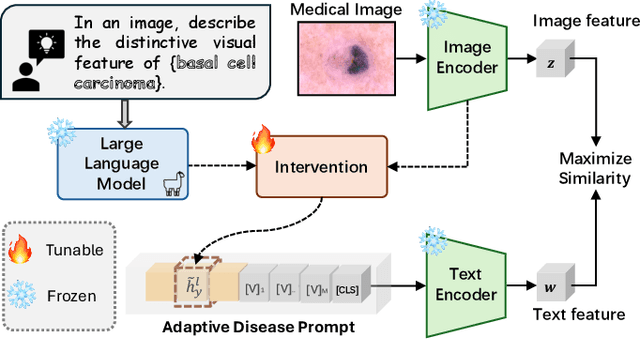
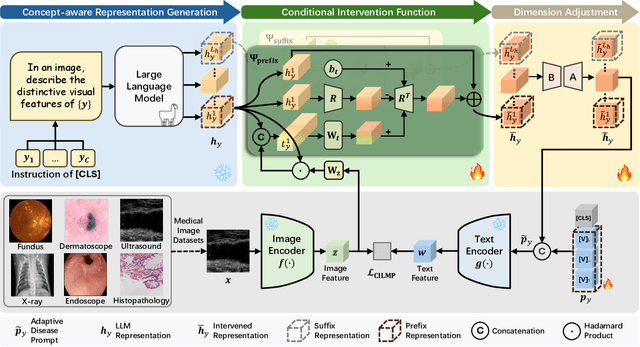
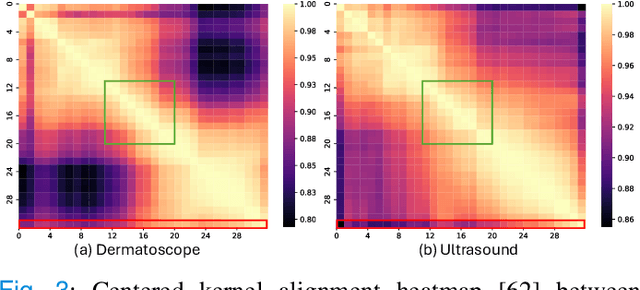
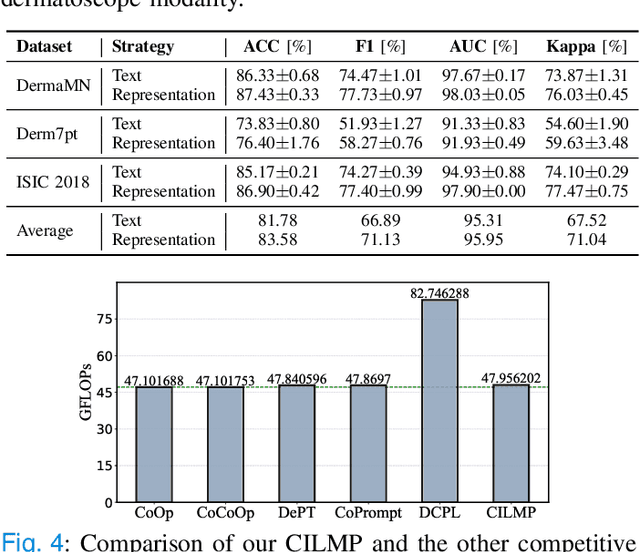
Abstract:Vision-language foundation models (VLMs) have shown great potential in feature transfer and generalization across a wide spectrum of medical-related downstream tasks. However, fine-tuning these models is resource-intensive due to their large number of parameters. Prompt tuning has emerged as a viable solution to mitigate memory usage and reduce training time while maintaining competitive performance. Nevertheless, the challenge is that existing prompt tuning methods cannot precisely distinguish different kinds of medical concepts, which miss essentially specific disease-related features across various medical imaging modalities in medical image classification tasks. We find that Large Language Models (LLMs), trained on extensive text corpora, are particularly adept at providing this specialized medical knowledge. Motivated by this, we propose incorporating LLMs into the prompt tuning process. Specifically, we introduce the CILMP, Conditional Intervention of Large Language Models for Prompt Tuning, a method that bridges LLMs and VLMs to facilitate the transfer of medical knowledge into VLM prompts. CILMP extracts disease-specific representations from LLMs, intervenes within a low-rank linear subspace, and utilizes them to create disease-specific prompts. Additionally, a conditional mechanism is incorporated to condition the intervention process on each individual medical image, generating instance-adaptive prompts and thus enhancing adaptability. Extensive experiments across diverse medical image datasets demonstrate that CILMP consistently outperforms state-of-the-art prompt tuning methods, demonstrating its effectiveness. Code is available at https://github.com/usr922/cilmp.
Exploring Scale Shift in Crowd Localization under the Context of Domain Generalization
Oct 22, 2025Abstract:Crowd localization plays a crucial role in visual scene understanding towards predicting each pedestrian location in a crowd, thus being applicable to various downstream tasks. However, existing approaches suffer from significant performance degradation due to discrepancies in head scale distributions (scale shift) between training and testing data, a challenge known as domain generalization (DG). This paper aims to comprehend the nature of scale shift within the context of domain generalization for crowd localization models. To this end, we address four critical questions: (i) How does scale shift influence crowd localization in a DG scenario? (ii) How can we quantify this influence? (iii) What causes this influence? (iv) How to mitigate the influence? Initially, we conduct a systematic examination of how crowd localization performance varies with different levels of scale shift. Then, we establish a benchmark, ScaleBench, and reproduce 20 advanced DG algorithms to quantify the influence. Through extensive experiments, we demonstrate the limitations of existing algorithms and underscore the importance and complexity of scale shift, a topic that remains insufficiently explored. To deepen our understanding, we provide a rigorous theoretical analysis on scale shift. Building on these insights, we further propose an effective algorithm called Causal Feature Decomposition and Anisotropic Processing (Catto) to mitigate the influence of scale shift in DG settings. Later, we also provide extensive analytical experiments, revealing four significant insights for future research. Our results emphasize the importance of this novel and applicable research direction, which we term Scale Shift Domain Generalization.
Language Model Based Text-to-Audio Generation: Anti-Causally Aligned Collaborative Residual Transformers
Oct 06, 2025Abstract:While language models (LMs) paired with residual vector quantization (RVQ) tokenizers have shown promise in text-to-audio (T2A) generation, they still lag behind diffusion-based models by a non-trivial margin. We identify a critical dilemma underpinning this gap: incorporating more RVQ layers improves audio reconstruction fidelity but exceeds the generation capacity of conventional LMs. To address this, we first analyze RVQ dynamics and uncover two key limitations: 1) orthogonality of features across RVQ layers hinders effective LMs training, and 2) descending semantic richness in tokens from deeper RVQ layers exacerbates exposure bias during autoregressive decoding. Based on these insights, we propose Siren, a novel LM-based framework that employs multiple isolated transformers with causal conditioning and anti-causal alignment via reinforcement learning. Extensive experiments demonstrate that Siren outperforms both existing LM-based and diffusion-based T2A systems, achieving state-of-the-art results. By bridging the representational strengths of LMs with the fidelity demands of audio synthesis, our approach repositions LMs as competitive contenders against diffusion models in T2A tasks. Moreover, by aligning audio representations with linguistic structures, Siren facilitates a promising pathway toward unified multi-modal generation frameworks.
A Survey of Scientific Large Language Models: From Data Foundations to Agent Frontiers
Aug 28, 2025



Abstract:Scientific Large Language Models (Sci-LLMs) are transforming how knowledge is represented, integrated, and applied in scientific research, yet their progress is shaped by the complex nature of scientific data. This survey presents a comprehensive, data-centric synthesis that reframes the development of Sci-LLMs as a co-evolution between models and their underlying data substrate. We formulate a unified taxonomy of scientific data and a hierarchical model of scientific knowledge, emphasizing the multimodal, cross-scale, and domain-specific challenges that differentiate scientific corpora from general natural language processing datasets. We systematically review recent Sci-LLMs, from general-purpose foundations to specialized models across diverse scientific disciplines, alongside an extensive analysis of over 270 pre-/post-training datasets, showing why Sci-LLMs pose distinct demands -- heterogeneous, multi-scale, uncertainty-laden corpora that require representations preserving domain invariance and enabling cross-modal reasoning. On evaluation, we examine over 190 benchmark datasets and trace a shift from static exams toward process- and discovery-oriented assessments with advanced evaluation protocols. These data-centric analyses highlight persistent issues in scientific data development and discuss emerging solutions involving semi-automated annotation pipelines and expert validation. Finally, we outline a paradigm shift toward closed-loop systems where autonomous agents based on Sci-LLMs actively experiment, validate, and contribute to a living, evolving knowledge base. Collectively, this work provides a roadmap for building trustworthy, continually evolving artificial intelligence (AI) systems that function as a true partner in accelerating scientific discovery.
ADAgent: LLM Agent for Alzheimer's Disease Analysis with Collaborative Coordinator
Jun 16, 2025Abstract:Alzheimer's disease (AD) is a progressive and irreversible neurodegenerative disease. Early and precise diagnosis of AD is crucial for timely intervention and treatment planning to alleviate the progressive neurodegeneration. However, most existing methods rely on single-modality data, which contrasts with the multifaceted approach used by medical experts. While some deep learning approaches process multi-modal data, they are limited to specific tasks with a small set of input modalities and cannot handle arbitrary combinations. This highlights the need for a system that can address diverse AD-related tasks, process multi-modal or missing input, and integrate multiple advanced methods for improved performance. In this paper, we propose ADAgent, the first specialized AI agent for AD analysis, built on a large language model (LLM) to address user queries and support decision-making. ADAgent integrates a reasoning engine, specialized medical tools, and a collaborative outcome coordinator to facilitate multi-modal diagnosis and prognosis tasks in AD. Extensive experiments demonstrate that ADAgent outperforms SOTA methods, achieving significant improvements in accuracy, including a 2.7% increase in multi-modal diagnosis, a 0.7% improvement in multi-modal prognosis, and enhancements in MRI and PET diagnosis tasks.
CorBenchX: Large-Scale Chest X-Ray Error Dataset and Vision-Language Model Benchmark for Report Error Correction
May 17, 2025Abstract:AI-driven models have shown great promise in detecting errors in radiology reports, yet the field lacks a unified benchmark for rigorous evaluation of error detection and further correction. To address this gap, we introduce CorBenchX, a comprehensive suite for automated error detection and correction in chest X-ray reports, designed to advance AI-assisted quality control in clinical practice. We first synthesize a large-scale dataset of 26,326 chest X-ray error reports by injecting clinically common errors via prompting DeepSeek-R1, with each corrupted report paired with its original text, error type, and human-readable description. Leveraging this dataset, we benchmark both open- and closed-source vision-language models,(e.g., InternVL, Qwen-VL, GPT-4o, o4-mini, and Claude-3.7) for error detection and correction under zero-shot prompting. Among these models, o4-mini achieves the best performance, with 50.6 % detection accuracy and correction scores of BLEU 0.853, ROUGE 0.924, BERTScore 0.981, SembScore 0.865, and CheXbertF1 0.954, remaining below clinical-level accuracy, highlighting the challenge of precise report correction. To advance the state of the art, we propose a multi-step reinforcement learning (MSRL) framework that optimizes a multi-objective reward combining format compliance, error-type accuracy, and BLEU similarity. We apply MSRL to QwenVL2.5-7B, the top open-source model in our benchmark, achieving an improvement of 38.3% in single-error detection precision and 5.2% in single-error correction over the zero-shot baseline.
Predicting Diabetic Macular Edema Treatment Responses Using OCT: Dataset and Methods of APTOS Competition
May 09, 2025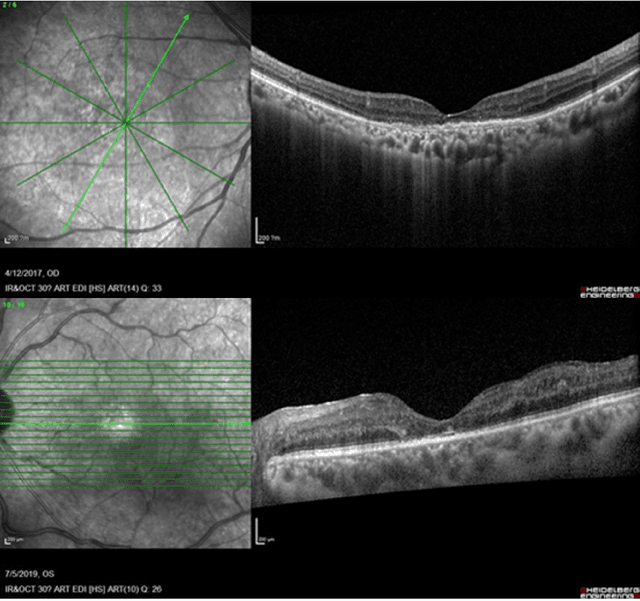
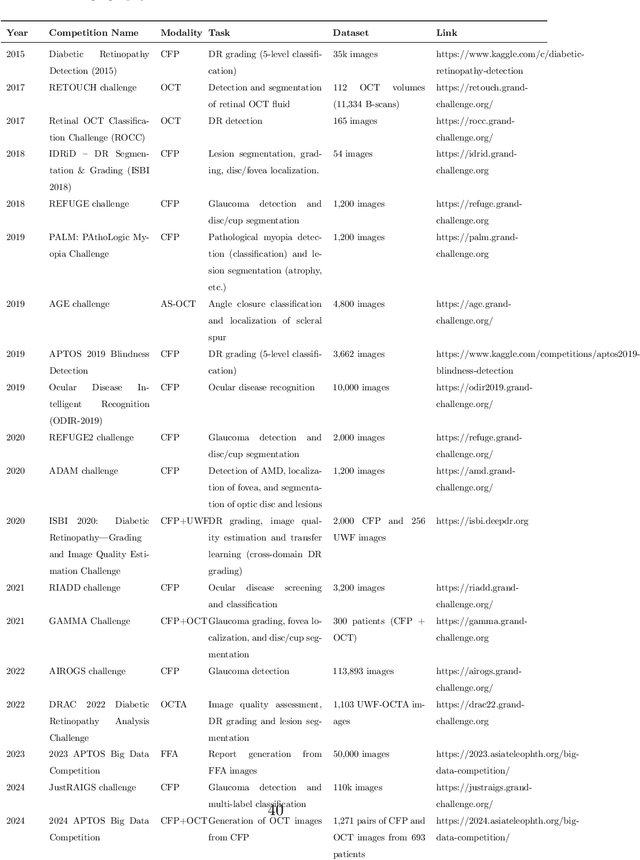
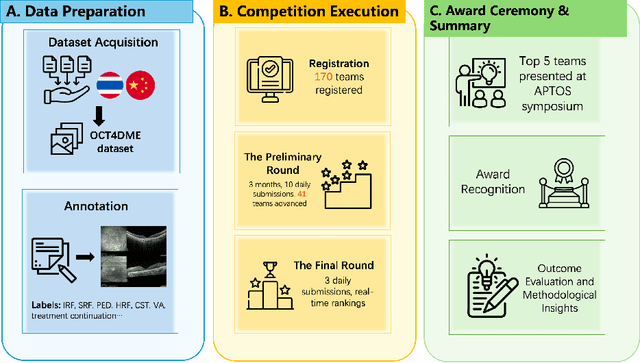

Abstract:Diabetic macular edema (DME) significantly contributes to visual impairment in diabetic patients. Treatment responses to intravitreal therapies vary, highlighting the need for patient stratification to predict therapeutic benefits and enable personalized strategies. To our knowledge, this study is the first to explore pre-treatment stratification for predicting DME treatment responses. To advance this research, we organized the 2nd Asia-Pacific Tele-Ophthalmology Society (APTOS) Big Data Competition in 2021. The competition focused on improving predictive accuracy for anti-VEGF therapy responses using ophthalmic OCT images. We provided a dataset containing tens of thousands of OCT images from 2,000 patients with labels across four sub-tasks. This paper details the competition's structure, dataset, leading methods, and evaluation metrics. The competition attracted strong scientific community participation, with 170 teams initially registering and 41 reaching the final round. The top-performing team achieved an AUC of 80.06%, highlighting the potential of AI in personalized DME treatment and clinical decision-making.
 Add to Chrome
Add to Chrome Add to Firefox
Add to Firefox Add to Edge
Add to Edge